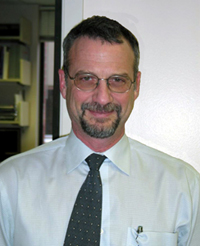 |
Ira Fox, M.D. |
Ira Fox, M.D., McLaughlin Professor of Surgery and senior associate dean for research in the UNMC College of Medicine, served as the senior author on the article and headed the study along with Naoya Kobayashi, M.D., Ph.D., of Okayama University Graduate School of Medicine and Dentistry in Japan.
In the study, the researchers generated liver stem cells from mouse embryos to help power a liver assist device in mice with acute liver failure. Typically, mice with acute liver failure die within a matter of days. However, using the liver assist device containing mouse liver cells derived from embryonic stem cells, 90 percent of the mice in the study experienced long-term survival.
After implanting the liver assist device seeded with the embryo-derived cells, the new cells developed characteristics nearly identical to those of primary hepatocytes (liver cells). The new cells filtered the blood much as the liver does, and kept the mice alive, while mice not fitted with the liver device died within two days.
The study was one of two articles in Nature Biotechnology this week that describe making liver cells from mouse embryonic stem cells. A research team at Mount Sinai School of Medicine in New York City headed the second study.
A third article in Nature Biotechnology, written by a San Diego research team, described an efficient method for converting human embryonic stem cells into cells that produce hormones made by the pancreas, a technique that could lead to a cure for diabetes.
“Both (liver) articles lay out a road map for how to regenerate a failed liver using embryonic stem cells,” Dr. Fox said. “The next step is to apply this approach to producing human liver cells.
“Our study is an important first step, but there’s still plenty of work to be done. Our work, and the other studies published this week, show we’re getting closer and closer (to making this applicable to humans).”
Embryonic stem cells are the body’s master cells and have the ability to transform into any kind of cell or tissue in the body.
Drs. Fox and Kobayashi have worked together for years on liver cell regeneration. Dr. Kobayashi worked at UNMC for two years completing his post-doctoral training under Dr. Fox during the late 1990s.
In 2005, two UNMC research teams – one headed by Dr. Fox, the other by Stephen Rennard, M.D., Larson Professor of Pulmonary Medicine – received training on how to use human embryonic stem cells in research. Both groups brought human embryonic stem cell lines back to Nebraska for their research. The embryonic stem cell lines are among the stem cell lines approved by President Bush.
A liver transplant surgeon, Dr. Fox is trying to determine if embryonic stem cells can be safely turned into liver cells that would ultimately be infused into failing livers. This form of therapy, cell transplantation, could be used as an alternative to organ transplantation for some patients with liver failure.
Due to the shortage of organ donors to meet the increased demand for organ transplants, Dr. Fox has, over the past decade, examined a variety of alternative ways – other than organ transplantation – to regenerate damaged livers. During this period, Dr. Fox has also studied the properties of adult stem cells and pig liver cells for this purpose.
Infusing human liver cells into a diseased liver in 1997, Dr. Fox was the first to get transplanted individual liver cells to partially correct a rare metabolic liver disease in a 10-year old child. In doing so, the patient was able to avoid undergoing a liver transplant for many years. The research was reported in the New England Journal of Medicine in May 1998.
Currently, more than 17,000 Americans are on the waiting list for a new liver. Liver failure can be caused by viruses such as hepatitis, by drug or alcohol damage and by a range of other diseases. Often the only cure is a transplant, and more than 5,000 liver transplants are done in the United States each year.